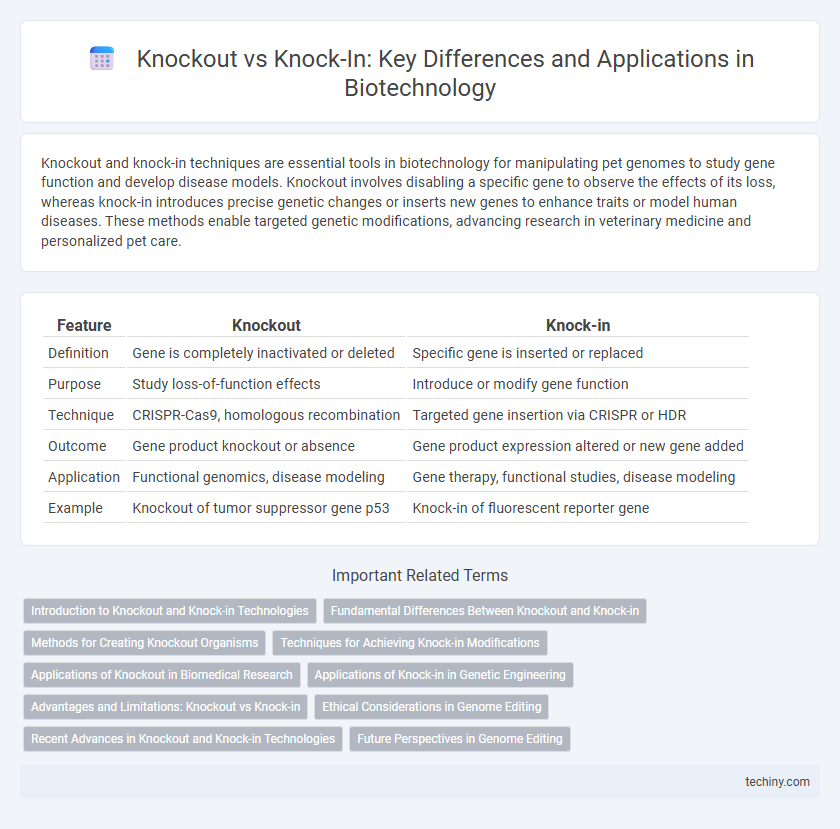Knockout and knock-in techniques are essential tools in biotechnology for manipulating pet genomes to study gene function and develop disease models. Knockout involves disabling a specific gene to observe the effects of its loss, whereas knock-in introduces precise genetic changes or inserts new genes to enhance traits or model human diseases. These methods enable targeted genetic modifications, advancing research in veterinary medicine and personalized pet care.
Table of Comparison
| Feature | Knockout | Knock-in |
|---|---|---|
| Definition | Gene is completely inactivated or deleted | Specific gene is inserted or replaced |
| Purpose | Study loss-of-function effects | Introduce or modify gene function |
| Technique | CRISPR-Cas9, homologous recombination | Targeted gene insertion via CRISPR or HDR |
| Outcome | Gene product knockout or absence | Gene product expression altered or new gene added |
| Application | Functional genomics, disease modeling | Gene therapy, functional studies, disease modeling |
| Example | Knockout of tumor suppressor gene p53 | Knock-in of fluorescent reporter gene |
Introduction to Knockout and Knock-in Technologies
Knockout and knock-in technologies are precise genetic engineering techniques used to modify specific genes within an organism's genome. Knockout involves the complete inactivation or deletion of a target gene to study its function by observing phenotypic changes, while knock-in involves the introduction or replacement of a specific DNA sequence at a particular gene locus, often to insert reporter genes or therapeutic mutations. Both methods utilize tools such as CRISPR-Cas9, TALENs, or zinc finger nucleases to achieve targeted gene editing with high efficiency and specificity.
Fundamental Differences Between Knockout and Knock-in
Knockout and knock-in techniques are fundamental genetic engineering methods used to modify specific genes within an organism's genome for research or therapeutic purposes. Knockout involves the complete inactivation or deletion of a target gene to study its loss-of-function effects, while knock-in refers to the insertion or replacement of a gene sequence to analyze gain-of-function or correct mutations. The primary difference lies in the genetic modification outcome: knockouts eliminate gene function, whereas knock-ins introduce precise genetic changes without gene loss.
Methods for Creating Knockout Organisms
CRISPR-Cas9 technology is a dominant method for creating knockout organisms by inducing double-strand breaks at specific genomic loci, leading to insertions or deletions that disrupt gene function. Zinc finger nucleases (ZFNs) and transcription activator-like effector nucleases (TALENs) are also employed to engineer targeted gene knockouts through precise DNA cleavage. Homologous recombination remains a traditional technique, especially in model organisms like mice, for replacing or disrupting genes to generate knockout phenotypes.
Techniques for Achieving Knock-in Modifications
Knock-in modifications in biotechnology are primarily achieved using CRISPR-Cas9 mediated homology-directed repair (HDR), enabling precise insertion of genetic material at target loci. Alternative techniques include CRISPR-based base editing and prime editing, which facilitate targeted nucleotide changes without inducing double-strand breaks. Electroporation and viral vector systems enhance the delivery efficiency of donor templates and editing components, improving knock-in success rates in a variety of cell types.
Applications of Knockout in Biomedical Research
Knockout technology enables targeted gene deletion to study gene function and disease mechanisms in biomedical research, often used to create animal models of human disorders such as cancer, diabetes, and neurodegenerative diseases. These models facilitate the investigation of gene roles in pathophysiology and the development of potential therapeutic interventions. Knockout mice remain crucial tools for validating drug targets and understanding gene-environment interactions in complex diseases.
Applications of Knock-in in Genetic Engineering
Knock-in technology enables the precise insertion of specific genes or mutations into an organism's genome, facilitating advanced studies in gene function and disease modeling. This method allows for the introduction of therapeutic genes, reporter tags, or regulatory elements, enhancing gene expression analysis and functional genomics. Knock-in approaches are crucial in developing personalized medicine, creating animal models that mirror human genetic disorders, and enabling targeted gene therapies.
Advantages and Limitations: Knockout vs Knock-in
Knockout techniques allow for the complete deletion of a target gene, enabling clear analysis of gene function but may cause compensatory biological effects or embryonic lethality. Knock-in methods insert or replace genetic sequences with high precision, facilitating the study of specific mutations or gene expression patterns but are often more time-consuming and technically challenging. Both approaches are essential in biotechnology for functional genomics, with knockouts providing definitive loss-of-function data and knock-ins offering nuanced insights into gene regulation and protein function.
Ethical Considerations in Genome Editing
Knockout and knock-in genome editing raise significant ethical considerations, particularly regarding unintended off-target effects and potential long-term consequences on human health and biodiversity. The irreversible nature of gene edits demands rigorous ethical scrutiny to balance therapeutic benefits against risks of genetic discrimination and consent complexities. Responsible governance and transparent stakeholder engagement are essential to navigating moral challenges in biotechnology advancements.
Recent Advances in Knockout and Knock-in Technologies
Recent advances in knockout and knock-in technologies have enhanced precision in genome editing through CRISPR-Cas9, base editors, and prime editing methods, enabling targeted gene disruption or insertion with higher efficiency and reduced off-target effects. Innovations in delivery systems, such as viral vectors and lipid nanoparticles, improve editing outcomes in diverse cell types and in vivo models. These technological improvements accelerate functional genomics research and therapeutic development by enabling precise genetic modifications with fewer unintended consequences.
Future Perspectives in Genome Editing
Knockout and knock-in technologies continue to revolutionize genome editing by enabling precise gene function studies and therapeutic target validation. Future advancements are expected to enhance the efficiency and specificity of CRISPR-Cas systems, facilitating complex genetic modifications for personalized medicine and regenerative therapies. Integration of machine learning with genome editing tools will accelerate the design of optimized sgRNAs, reducing off-target effects and expanding applications in synthetic biology and disease modeling.
**Knockout vs Knock-in** Infographic

 techiny.com
techiny.com